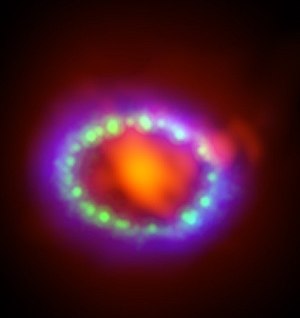SN 1987a

|
|
| Other designations | SN 1987A, AAVSO 0534-69 |
|---|---|
| Event type |
Supernova |
| Spectral class | Type II (peculiar) |
| Observation | |
| Date | 24 February 1987 (23:00 UTC) Las Campanas Observatory |
| Location | |
| Constellation | Dorado |
| Right ascension | 05h 35m 28.03s |
| Declination | −69° 16′ 11.79″ |
| Epoch | J2000 |
| Galactic coordinates | G279.7-31.9 |
| Distance | 167,885 ly (51.474 kpc) |
| Host | Large Magellanic Cloud |
| Characteristics | |
| Progenitor | Sanduleak -69° 202 |
| Progenitor type | B3 supergiant |
| Colour (B-V) | +0.085 |
| Notable features | Closest recorded supernova since invention of telescope |
| Energetics | |
| Peak apparent magnitude | +2.9 |
| See also | |
|
[]
|
|
SN 1987A was a supernova in the outskirts of the Tarantula Nebula in the Large Magellanic Cloud (a nearby dwarf galaxy). It occurred approximately 51.4 kiloparsecs from Earth, approximately 168,000 light-years, close enough that it was visible to the naked eye. It could be seen from the Southern Hemisphere. It was the closest observed supernova since SN 1604, which occurred in the Milky Way itself. The light from the new supernova reached Earth on February 23, 1987. As it was the first supernova discovered in 1987, it was labeled “1987A”. Its brightness peaked in May with an apparent magnitude of about 3 and slowly declined in the following months. It was the first opportunity for modern astronomers to study the development of a supernova in detail, and observations have provided much insight into core-collapse supernovae. Of special importance, SN1987A provided the first chance to confirm by direct observation the radioactive source of the energy for visible light emissions by detection of predicted gamma-ray line radiation from two of its abundant radioactive nuclei, 56Co and 57Co. This proved the radioactive nature of the long-duration post-explosion glow of supernovae.
SN 1987A was discovered by Ian Shelton and Oscar Duhalde at the Las Campanas Observatory in Chile on February 24, 1987, and within the same 24 hours independently by Albert Jones in New Zealand. On March 4–12, 1987, it was observed from space by Astron, the largest ultraviolet space telescope of that time.
...
Wikipedia
